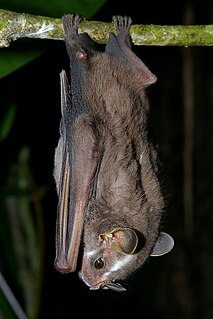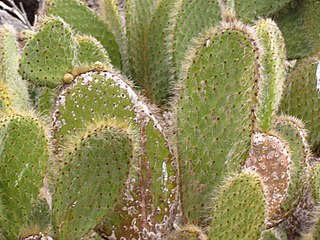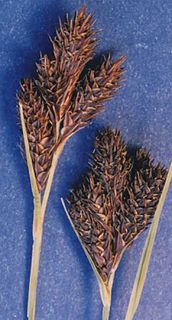
Rhabdophis subminiatus, commonly called the red-necked keelback, is a species of highly venomous snake in the family Colubridae. The species is endemic to Asia.

Crotalus oreganus helleri is a venomous pit viper subspecies found in southwestern California and south into Baja California, Mexico.
The Taita thrush, also known as Taita olive thrush or Heller's ground thrush, is a critically endangered bird from the family of thrushes (Turdidae), endemic to the Taita Hills in Kenya.

Edmund Heller was an American zoologist. He was President of the Association of Zoos & Aquariums for two terms, from 1935-1936 and 1937-1938.

Heller's broad-nosed bat is a bat species from South and Central America.

Platyrrhinus is a genus of leaf-nosed bats in the tribe Stenodermatini of family Phyllostomidae. Twenty one species are known:

Scalesia helleri is a species of flowering plant in the Asteraceae family. It is endemic to the Galápagos Islands.
The puna thistletail is a species of bird in the Furnariidae family. It is found in Peru and Bolivia.

Opuntia helleri is a species of plant in the family Cactaceae. This vulnerable species is endemic to the Galapagos Islands (Ecuador), where restricted to Wolf, Darwin, Marchena, and Genovesa.

Carex helleri is a species of sedge known by the common name Heller's sedge. It is native to eastern California and western Nevada, where it grows on rocky mountain slopes and in other habitats.

The green swordtail is a species of freshwater/brackish fish in family Poeciliidae of order Cyprinodontiformes. A live-bearer, it is closely related to the southern platyfish or ‘platy’ and can crossbreed with it. It is native to an area of North and Central America stretching from Veracruz, Mexico, to northwestern Honduras.
Ocinebrina helleri is a species of sea snail, a marine gastropod mollusk in the family Muricidae, the murex snails or rock snails.

Liatris helleri is a species of flowering plants in the aster family known by the common names Heller's blazing star and Heller's gayfeather. It is native to the Appalachian Mountains of the southeastern United States, found in the states of North Carolina, Virginia, West Virginia, and Maryland. It is threatened by recreational activities in its habitat, and is federally listed as a threatened species.
Schiedea helleri is a rare species of flowering plant in the pink family known by the common names Heller's schiedea and Kaholuamanu schiedea. It is endemic to Hawaii, where it is known only from the island of Kauai. It is threatened by the degradation of its habitat. It was federally listed as an endangered species of the United States in 1996.

Sybra is a genus of beetles in the family Cerambycidae, containing the following species:
Monstropalpus helleri is a species of beetle in the family Cerambycidae, and the only species in the genus Monstropalpus. It was described by Franz in 1953.

Sybra umbratica is a species of beetle in the family Cerambycidae. It was described by Pascoe in 1865.

Sybra ordinata is a species of beetle in the family Cerambycidae. It was described by Bates in 1873.
Sybra pascoei is a species of beetle in the family Cerambycidae. It was described by Lameere in 1893.
The slender broad-nosed bat is a species of bat in the family Phyllostomidae. As a phyllostomid bat, it is characterized by a narrow uropatagium which is fringed with hair; a white dorsal stripe; large inner upper incisors convergent at the tips; and three upper and three lower molars. It is found in eastern Colombia and Ecuador, north-eastern Peru, and Venezuela. It is closely related to Platyrrhinus incarum and Platyrrhinus fusciventris.













